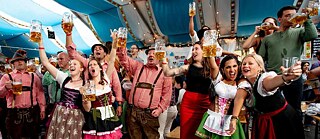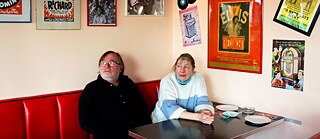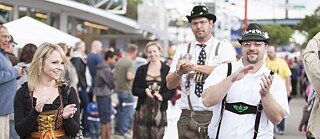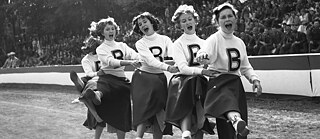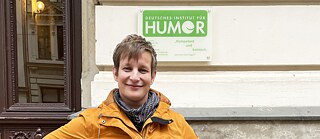Craft beer continues to explode in popularity
Suds and Stories
Germany’s beer influence has swept the world, and one epicenter of the trend is New York City. There are over two dozen beer gardens and halls in the city — and every year, weeks of Oktoberfest celebrations are held in all of the five boroughs.
Listen to this episode: Apple Music | Spotify | Download
This episode is by Wendy Gillette. Wendy is an anchor for CBS Network Radio as well as a correspondent, producer, and editor for CBS Newspath. She is based in New York City. In this podcast, Wendy talks to the owners of several bars and breweries in The Big Apple and their patrons. For the episode, she visits Zum Schneider NYC, Three’s Brewing, and Radegast Hall and Biergarten. The featured photo was taken at Zum Schneider NYC.
Transcript
Wendy Gillette: I’m Wendy Gillette, listening to a few traditional tunes ...
[MUSIC PLAYING]
Wendy Gillette: ... at Munich on the East River, in Manhattan. It’s a gorgeous, sunny fall day. The ones that feel like summer will never end. But here it’s all about October — or Oktoberfest, I should say. Every fall, New York goes gaga for Germany. Fashion week gives way to dirndls and lederhosen — roomy enough to allow for all those giant pretzels and beer steins.
[TOASTING]
Wendy Gillette: There are Oktoberfest celebrations in all of the city’s five boroughs ... in beer gardens, parks, on boats, and under tents. Like this one, where about a quarter of the crowd dons some sort of traditional dress. Some more traditional than others. There’s Jean Carlo Perez.
Describe what’s around your neck.
Jean Carlo Perez: I have an inflatable pretzel. Uh, with some salt particles painted on it. It’s — it’s fun.
Wendy Gillette: Why are you wearing it?
Jean Carlo Perez: ’Cause it’s German. It’s German tradition, you know?
Wendy Gillette: Liam Cain follows that same trend.
Liam Cain: My friend told me to come to German fest and if I don’t own a personal pair of lederhosen, to at least go online and find a T-shirt that’s got the fake lederhosen. And I was like, all right I’ll do it.
Wendy Gillette: It’s his first Oktoberfest in New York, but likely not his last — since his list of what he’s enjoying is long.
Liam Cain: Even though I’m not German, it’s kind of like St. Patrick’s Day where everyone’s German. The Wiener schnitzel, the bratwurst, the beers. The women look great and like — the music is hilarious. I mean, they go from like, German polka to, like ... mariachi songs. It’s — I don’t know. It’s fun.
Wendy Gillette: One of those great-looking women: Sandra Tobar, who just arrived home from Germany.
Sandra Tobar: I just came back from the Black Forest, so I figured I’d join New York City with their Oktoberfest. Basically, to see the difference between the German Oktoberfest and the New York City Oktoberfest.
Wendy Gillette: Tell me what the difference is between there and here.
Sandra Tobar: Uh, it’s this, basically — to the 10th power. There’s so many people running around dressed exactly like me.
Wendy Gillette: She’s wearing a dirndl — that traditional dress. But again, not so traditional.
Sandra Tobar: A traditional one is a little bit longer than this, but for Oktoberfest, they wear it a little bit shorter.
Wendy Gillette: So it’s a little bit higher in the skirt and a little bit lower in the cleavage.
Sandra Tobar: Yes. So the lady who sold it to me — she got me a very conservative blouse, and it’s button-down and crocheted. But I kind of wanted to flash a little bit of the girls, and I got the one that was a little bit lower. Shows a lot of cleavage. Um, it’s just a fun thing. Maybe uh ... it just gets all the men crazy with beer.
Wendy Gillette: They start the men young here. John Gladysz brought his son.
John Gladysz: Jack’s wearing authentic lederhosen from Germany. And a blue Polo Ralph Lauren shirt — so he got his American and German coming together.
Wendy Gillette: I should mention, Jack just turned one. And he’s adorable. It’s just the kind of crowd the founder of the festival, German native Sylvester Schneider, wanted to attract.
Sylvester Schneider: There’s a word called ‘Gemütlichkeit.’ It’s uh — the closest translation is ‘coziness.’ So, it’s really a get together of people from zero to 100 years. And that’s really a thing that’s becoming more and more difficult in our society. Everything gets so segregated. And rules — so many rules and stuff. And the Bavarian culture really still brings together all generations and puts them into one situation that everybody’s happy.
Wendy Gillette: Schneider also provides plenty of happiness for himself. He greets me with a stein in his hand and a smile on his face.
Wendy Gillette: How many beers you’ve had so far?
Sylvester Schneider: About 15.
Wendy Gillette: Are you serious?
Sylvester Schneider: Yeah, during the course of the last three days — for sure.
Wendy Gillette: But his true joy lies elsewhere.
Wendy Gillette: What brought you to the U.S.?
Sylvester Schneider: Uh ... music? I’m a musician. I wanted to become a rock star and, um, I wanted to study music. I was at Berklee College of Music for a while, and um ... then I had kids. I had to do something different than just play music, so I started a bar-restaurant and I combined it with the music, so I play the music at my own bar.
Wendy Gillette: The bar is Zum Schneider where all the staff speak fluent German and English. The band is Moesl-Franzi and the JaJaJas.
Sylvester Schneider: In my late teens, I was in a jazz band. I was in an afro, afrobeat band. I was in a ... in a rock band. We played, like — a cover band with Frank Zappa songs.
Wendy Gillette: What kind of music do you play now?
Sylvester Schneider: Ummm ... it’s like punk rock polka.
Wendy Gillette: What’s that?
Sylvester Schneider: You’ll hear in a minute.
Wendy Gillette: There’s a lot of fanfare before Schneider actually takes the stage as lead singer and drummer.
[CHANTING, TOASTING, AND SINGING]
Wendy Gillette: At long last, after many a clanging stein, the set starts.
[SINGING]
Wendy Gillette: The festival has grown from just inside the bar to 8,000 people attending over eight days. It’s certainly not how Schneider pictured his life growing up in Germany. He was eager to escape its traditions.
Sylvester Schneider: I ran away from Germany because of all of that, and then I recreated it in the U.S. Um, no, uh, the whole reason was really homesickness. I was missing the beer gardens and the beer.
Wendy Gillette: Back then, beer gardens were few and far between in New York. Now, there are dozens. From Harlem to midtown Manhattan, to inside Citi Field where the Mets play ...
[METS PLAYING]
Wendy Gillette: ... to Williamsburg, Brooklyn.
[BAND PLAYING]
Wendy Gillette: Brass bands stroll through the crowd every Saturday at Radegast Hall and Biergarten. A retractable roof peels back to expose long wooden tables — and a grill stand pumping out dripping sausages — to the light. Ivan Kohut opened the bar in 2007.
Ivan Kohut: I never actually, uh ... was able to actually go to a bar that I really liked. Uh, my standards were high.
Wendy Gillette: He created a rollicking party, where liter beers are the norm and the promise of a stranger awaits right at your table, according to the bar’s general manager, Mystik Dasilva.
Mystik Dasilva: The time that it opened up, there was nothing else like it. Big long farm tables. Loud music, big beers in big steins. I think it’s tradition, but I also think it’s great — to have these big long communal tables where it brings people together. And it makes people who don’t know each other talk to each other. I get emails from people saying, I met my boyfriend there one drunk Saturday. Or me and my boyfriend met outside, or in the beer hall. Or came to see live music ... so we definitely are a good hookup place.
Wendy Gillette: How many beers do you sell on a typical Saturday?
Mystik Dasilva: On a typical Saturday, I would say it would be in the thousands.
Wendy Gillette: Why do people like to have the liters?
Mystik Dasilva: I think people like to be seen with a really big beer. I think it makes them think they look cool. And I also think with having a liter of beer, it saves you from having to go to the bar every 20 minutes.
Wendy Gillette: There are no American beers here, only European. Kohut says customers appreciate that.
Ivan Kohut: They love to travel. They’re people of the — of the earth. Rather than just in the United States, kind of ... you know: we’re here, we’re the best.
Wendy Gillette: The bar follows in the footsteps of breweries that once dominated Brooklyn. Historians say more than 100 were making beer in 1880, mostly in Bushwick and Williamsburg. German immigrants led the way in the 1830s, bringing their tradition of lagers and changing the way beer was made in the U.S. Kohut says making beer was on his mind in 2007.
Ivan Kohut: But unfortunately, during these times, it was — it was just too difficult.
Wendy Gillette: A few short years later, the landscape for breweries in New York City shifted. Joshua Stylman is a cofounder and CEO of Three’s Brewing in Gowanus, Brooklyn, which opened in 2014.
Wendy Gillette: What’s the craft beer scene like in New York City?
Joshua Stylman: It’s flourishing, I guess, to start. Um, so there are a lot of breweries in New York. And you couldn’t make that claim just five years ago.
Wendy Gillette: It’s difficult for him to even estimate how many there are.
Joshua Stylman: Offhand, I don’t know. And if I said the number, it would go up quickly the moment after I said it. I’ll say dozens at this point.
Wendy Gillette: Why do you think so many breweries started right around the same time?
Joshua Stylman: Because there were no breweries in New York City. Which — I think we saw firsthand why when we started doing construction. Construction in New York is terrible.
[HONKING HORNS]
Wendy Gillette: Stylman is referring to the sometimes overwhelming traffic, difficulty parking, getting permits for manufacturing, the logistics of deliveries ...
Joshua Stylman: It’s really hard to do what we do here in New York. But it also has its advantages. So, for example — you know, we have the benefit of urban density. So we open our bar on a Saturday, and we get a lot of people coming through here. That’s unusual if we were a brewery doing this outside of New York City ... and lots of places around the country, for that matter.
Wendy Gillette: New York City can be a cutthroat, competitive place. So you would think that might extend to the industry. But Stylman says the opposite is true.
Joshua Stylman: We’re all kind of between one and six years old at this point — the lion’s share. So we’ve got this really great cohort group that all shares knowledge, recipes, ingredients. Um, you know — sometimes talent. So you know, there’s ... unlike a lot of industries I’ve seen, where there’s fierce competition. I mean, we all — we all compete with each other. We compete for tap lines and bars. We compete for mindshare, you know — hearts and minds of our customers. There’s this real sense of camaraderie. And I think, in this world, the sense is that there’s kind of the rising tides thing? That we’re all kind of in this together? And we’re all really genuinely pulling for each other, out of — out of friendship, first and foremost.
Wendy Gillette: And the demand for well-crafted beer doesn’t seem to be slowing.
Joshua Stylman: For many years in the United States, I think people all thought beer tastes the same. I think in some respects, the beer thing is just an extension of the food movement. So there are really fine dining restaurants, for example — that a few years ago didn’t care about their beer lists — are now starting to call us. And say: hey, we — we no longer, you know, want to carry some generic beer that our customers, you know, aren’t asking for. They want something — there’s this insatiable appetite for local. There’s this insatiable appetite for craft.
Wendy Gillette: Three’s Brewing is one of the best. Winning awards — including the top beer brewed in New York State in both 2017 and 18 — beating out hundreds of entries in blind taste tests.
Joshua Stylman: Most of our beers — if you’re ... if you’re really into beer, and you want to stick your nose in it and be one of those people and try to find notes and different flavors — you can do that. There’s some nuance. If you just want to crush beer with your friends at the beach or a bar, our beers are really good for that too. They’re pretty accessible.
Wendy Gillette: Customer Andy Mills is in the latter group.
Andy Mills: A lot of the beer they have is made to just ... like, drink. It’s not made to like, sip on. And, you know, pontificate about.
Wendy Gillette: The brand certainly does not take itself seriously — most markedly, in its descriptions of how each of the beers tastes. Cofounder Justin Israelson.
Justin Israelson: We were kind of ... just, like, riffing off of — like, the wine world, in a way. Like, they’re very specific in the way they describe their wines. We thought it would be fun to do the same with beer.
Joshua Stylman: We try to describe the beer in about four or five words. And sometimes they say things like ‘Mountain Dew’ or ‘burnt Oreos.’ And invariably, customers look at the menu and say: You made this with Mountain Dew? I don’t want to drink Mountain Dew. And of course, we don’t. It’s just — we’re trying to ... we’re trying to describe flavors that you might be familiar with to describe the beer. And oftentimes, we’ll have fun with it. We used, uh — ‘Florida Man’ in one. ‘Florida Man.’ You heard me.
Wendy Gillette: ‘Florida Man’?
Joshua Stylman: It was a goof. So we try to, we try to have a little bit of fun with this.
Wendy Gillette: What does ‘Florida Man’ smell like?
Joshua Stylman: Uh, I’d rather not comment on that.
Wendy Gillette: But it’s not all fun and games. The challenges of brewing in New York City remain.
Joshua Stylman: The biggest complication about making beer in New York City is space. Uh, we don’t have enough of it. Particularly for a brewery like ours, that is making a lot of beer ... but has demand that is outweighing our supply. We simply can’t make enough beer. And that’s — that’s a big challenge.
Wendy Gillette: Stylman gave me a tour of the brewery, where a skylight was required to make room for the equipment.
Joshua Stylman: If you’ve ever been to a proper production brewery, this is kind of ... uh, this is not how you’re supposed to do this. This is like the New York City studio apartment version of a brewery. We’re kind of like a cruise ship. There is a — there is a designated spot for every single thing we have here in the brewery.
Wendy Gillette: But the buzz of his new life far outweighs the lows — what he calls a midlife crisis project, trading in the tech world for taps. Customers like Mills say there’s only one issue.
Andy Mills: As a person who lives in the neighborhood, like, the biggest problem that I have with it — is that too many people know about it. And they come here with their good-looking dates, and they crowd the place up, and — uh, I would like to ... to have it a little bit more to myself.
Wendy Gillette: That kind of popularity is a dilemma any business would love to have. In New York, I’m Wendy Gillette.



